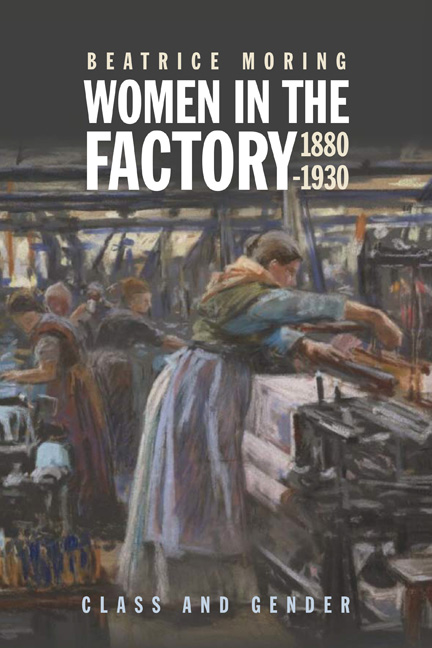Book contents
- Frontmatter
- Contents
- List of Illustrations
- Introduction – Why Women in the Factory?
- 1 Gender And Class – Male Unions, Political Movements and the Female Vote
- 2 Women in Industry: Work, Sectors, Age and Marital Status
- 3 Women, Earnings and the Household – Why the Factory?
- 4 Accidents, Compensation, Laws and Inspection
- 5 Middle Class Girls, Education and Entry into the Civil Service
- 6 The Female Factory Inspectors – How, Why and Who
- 7 Factory Inspection Activity
- 8 Class, Gender and Communication
- Conclusion
- Appendix 1 The Right for Women to Vote in National Elections
- Appendix 2 Women in the Workforce
- Appendix 3 Women, Work, Earnings and Family
- Appendix 4 Accidents, Workplace Acts and Regulations
- Appendix 5 Education
- Appendix 6 Female Inspectors
- Appendix 7 Inspectors, Activity
- Appendix 8 The Female Inspectors and Society
- Bibliography
- Index
5 - Middle Class Girls, Education and Entry into the Civil Service
Published online by Cambridge University Press: 09 May 2024
- Frontmatter
- Contents
- List of Illustrations
- Introduction – Why Women in the Factory?
- 1 Gender And Class – Male Unions, Political Movements and the Female Vote
- 2 Women in Industry: Work, Sectors, Age and Marital Status
- 3 Women, Earnings and the Household – Why the Factory?
- 4 Accidents, Compensation, Laws and Inspection
- 5 Middle Class Girls, Education and Entry into the Civil Service
- 6 The Female Factory Inspectors – How, Why and Who
- 7 Factory Inspection Activity
- 8 Class, Gender and Communication
- Conclusion
- Appendix 1 The Right for Women to Vote in National Elections
- Appendix 2 Women in the Workforce
- Appendix 3 Women, Work, Earnings and Family
- Appendix 4 Accidents, Workplace Acts and Regulations
- Appendix 5 Education
- Appendix 6 Female Inspectors
- Appendix 7 Inspectors, Activity
- Appendix 8 The Female Inspectors and Society
- Bibliography
- Index
Summary
I was the only girl in the college. It caused a terrible stir. The priest in my home town who used to play cards with my father said to him: ‘Mr Einstein, I am sorry to say that I cannot play cards with you any longer as you have sent Herta to a boys’ school and by doing so you are supporting the destruction of morals’.
In the late nineteenth century, women had made considerable progress into the educational system. From societies with little or no formal education for women in the early 1800s, schools, exams and even universities had opened their doors for girls. In some cases, the origins of the development can be found in the Enlightenment, in other cases, political, economic or other local issues contributed to the increased inclusion of women in educational efforts. In large parts of Europe, however, the activity of the nineteenth-century women's movements focused on female access to education and the right to use accrued knowledge by taking office within wider society. The education system, healthcare and social care were logical extensions of the female sphere. The civil service, however, a logical enough route for educated women, was for a long time closed, until new innovations created activities deemed suitable for women. Female entry into social welfare activities related to women and children also found support in many quarters.
While the increase in access to education followed similar patterns of development, one should not ignore the influence of the higher degree of involvement by the state or local administration in continental and Northern Europe in comparison with the private nature of education in Britain and the USA.
The early steps for including girls into the education system in post-revolutionary France had their roots in the 1830s and the first teacher training school, the Normal School for Girls, was founded in 1838. For a long time the Catholic Church had a strong grip on the female educational sector and from 1867 this virtual monopoly was contested by the state. The private sector had been offering women teacher training from the 1850s but not until the 1880s was a state secondary schools system created for women.
- Type
- Chapter
- Information
- Women in the Factory, 1880-1930Class and Gender, pp. 120 - 139Publisher: Boydell & BrewerPrint publication year: 2024



